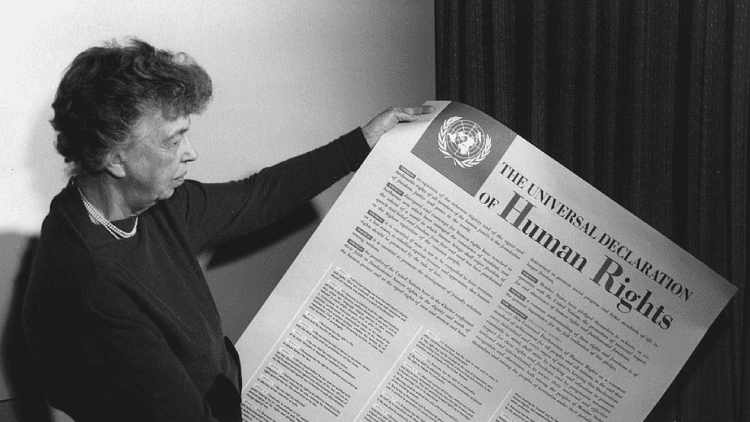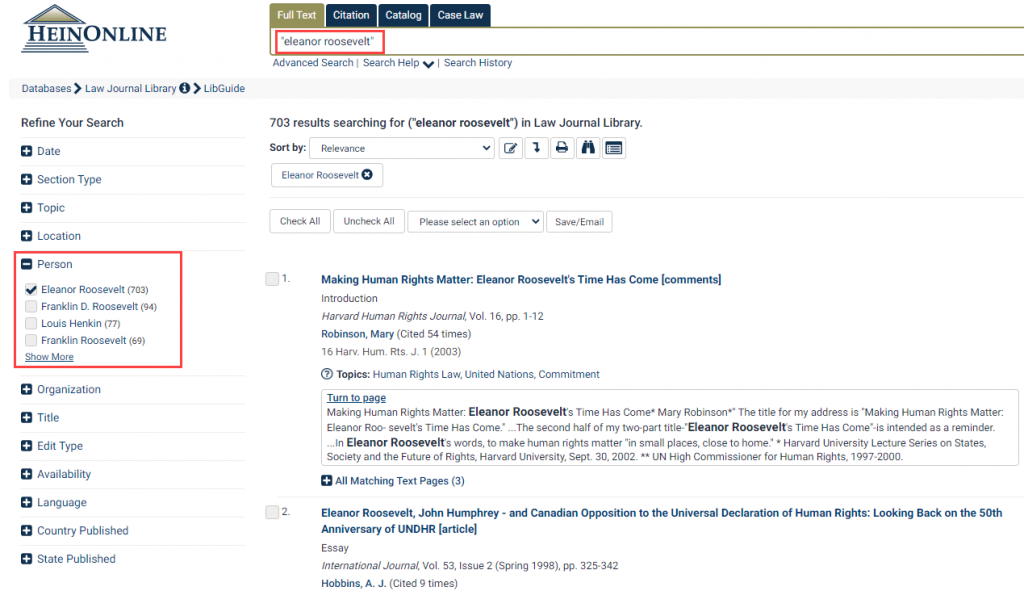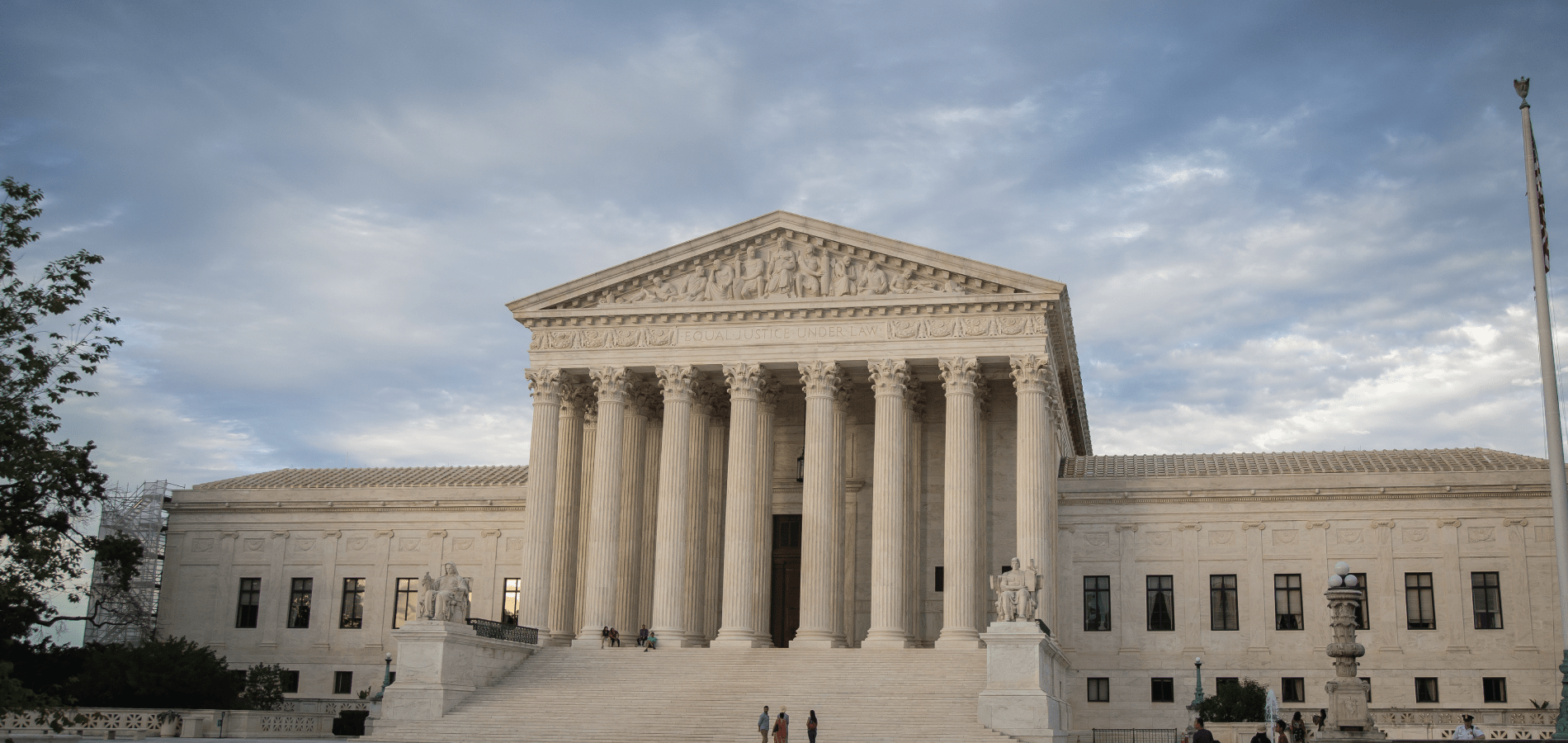Anna Eleanor Roosevelt is well-known for her role as First Lady to the longest-sitting president in American history. In reality, she was much more than that, demonstrating throughout her life that she was also, among many things, an accomplished businesswoman, a passionate civil rights activist, and a skillful diplomat.
This past Sunday would have been Eleanor Roosevelt’s 136th birthday. Join HeinOnline in exploring ten lesser-known facts about the unforgettable “First Lady of the World” with the following databases:
- Reports of U.S. Presidential Commissions and Other Advisory Bodies
Named to the 2018 List of Best Historical Materials - United Nations Law Collection
- U.S. Congressional Serial Set
- U.S. Presidential Library
- U.S. Statutes at Large
- Women and the Law
1. Her maiden name was Roosevelt.
Eleanor Roosevelt was not a member of the prominent Roosevelt family by marriage, but was a Roosevelt in her own right. She and her husband, Franklin Delano Roosevelt, were actually fifth cousins once removed. Eleanor herself was the niece of Theodore Roosevelt, who, just thirteen days after beginning his presidency, attended Eleanor’s wedding to walk her down the aisle in 1905.
2. She is one of the main reasons why FDR became President.
In 1920, Eleanor made her first real public appearances when her husband campaigned for the Democratic vice presidency. Soon after losing the election, Franklin Roosevelt experienced an illness that left him permanently paralyzed from the waist down, causing him to consider retirement from public life. Eleanor insisted, however, that her husband should remain in politics, and she herself maintained his political career by making appearances on his behalf. The contacts she made during this time cemented her role in the Democratic Party, and won her husband support for his future presidential campaign.

3. She was an accomplished businesswoman.
In 1927, Eleanor embarked on two business ventures—buying the Todhunter School for Girls and establishing Val-Kill Industries on the Roosevelt family estate. In buying the school, she advanced the Progressive Education movement and began teaching three days a week. Through Val-Kill Industries, she and her partners established a furniture, pewter, and cloth factory to provide supplemental income for local families. In 1977, the site of Val-Kill Industries was designated by Congress as the “Eleanor Roosevelt National Historic Site.”
4. She was reluctant to become the First Lady.
Eleanor Roosevelt became First Lady of the United States when her husband was inaugurated in March of 1933. However, she was less than thrilled to take on this new role. Traditionally, First Ladies would let go of their causes, if they had any, upon entering the White House, and were limited to a life of relative domesticity. For example, just a few years earlier, Lou Henry Hoover (wife to President Herbert Hoover) had abandoned her feminist activism when her husband was inaugurated in 1929.
Instead of following in Lou Hoover’s footsteps, Eleanor defied the then-natural role of the First Lady and continued to actively speak, write, and do business, to much criticism.
5. She was the first First Lady to ever hold a press conference.
Over the 12 years that her husband was president, Roosevelt held 348 press conferences. She held her first (and the first for any First Lady) only two days after her husband’s inauguration. From that point forward, Roosevelt’s conferences were open to women only, banning all male reporters so that newspapers would be pressured to retain and hire more female journalists. With this platform, Roosevelt defended her husband’s New Deal programs and discussed issues that arose during World War II.
6. She single-handedly defused a tense march on Washington.
In 1932, during Hoover’s presidency, a group of World War I veterans known as the “Bonus Army” launched a protest in D.C., demanding early cash redemption of their service certificates. The protest was met with violence, first from D.C. police and then from the U.S. Army, under Hoover’s orders. In 1933, after FDR assumed the presidency, the Bonus Army marched again, but this time, Eleanor visited with the veterans to discuss their concerns, share a meal, and bond over song. She ultimately offered them a promise of stable jobs within the newly established Civilian Conservation Corps (CCC), which appeased most of the protestors.
7. She was an ardent civil rights activist, even in the face of criticism.
History remembers Eleanor fondly now for her outspokenness, but this was often criticized by her contemporaries, particularly when it was about civil rights. In 1938, she attended an Alabama conference on human welfare where the audience had been segregated by race. She purposely sat down on the black side, and when asked by police to move, placed her chair in the middle of the aisle, between the segregated sections. Separately, after evaluating the implementation of some of FDR’s New Deal programs, she was not afraid to voice (loudly) that the programs were discriminatory against African Americans and thus in need of further reform.
That’s not the only time she publicly disagreed with her husband. In 1941, Japan’s attack on Pearl Harbor heightened existing prejudice against Japanese-Americans, and soon after, FDR issued Executive Order 9066, calling for the relocation of all Japanese-Americans on the West Coast to government-run concentration camps. Eleanor disagreed with the order and spoke out publicly against Asian-American prejudice, to heavy criticism.
8. She played an instrumental role in the global recognition of human rights.
Eleanor’s life changed in 1945 when her husband died. She was no longer the First Lady of the United States. However, her work was not finished. In December of the same year, President Harry S. Truman appointed Roosevelt as one of the first American delegates to the United Nations General Assembly. In its first session on January 10, 1946, Eleanor gathered 17 women from 11 countries and led the drafting of an “Open Letter to the Women of the World.”
By April, she had become the first chairperson of the United Nations Commission on Human Rights. During her time in this role, she led the creation of an international legal document that would outline the rights and freedoms of all humans—the Universal Declaration of Human Rights. Read more from Eleanor about the drafting of this monumental document, an accomplishment which led President Truman to nickname Roosevelt the “First Lady of the World.”

9. She chaired the Presidential Commission on the Status of Women.
Eleanor’s work for the betterment of the nation (and for each of its citizens) continued through to the end of her life. In 1961, President John F. Kennedy established the President’s Commission on the Status of Women, an issue dear to Eleanor’s heart. On the commission’s agenda was discussion of the proposed Equal Rights Amendment, a guarantee of equal legal rights for all Americans, regardless of sex, and thus an elimination of legal distinctions between men and women. Roosevelt had long opposed the idea on the basis that it would undermine protective legislation that had been instituted over decades for women, particularly in the workplace.
Eleanor Roosevelt died of cardiac failure on November 7, 1962. Read memorial addresses and tributes from Congress, dedicated to her life and legacy.
Unfortunately, she didn’t live to see the final report of the President’s Commission on the Status of Women, which concluded that recognition of gender differences and needs were necessary for true gender equality, rather than what was proposed by the Equal Rights Amendment. In addition to the final report, find reports from several committees on the commission in HeinOnline’s Reports of U.S. Presidential Commissions database.
10. In her honor, Bill Clinton established the Eleanor Roosevelt Award for Human Rights.
On the 50th anniversary of the Universal Declaration of Human Rights, President Bill Clinton honored Eleanor, the “driving force” behind the document, with the creation of the Eleanor Roosevelt Award for Human Rights. Clinton presented the award to American humanitarians and activists throughout his administration, as did Secretary of State Hillary Rodham Clinton during the Obama administration.
For Eleanor Roosevelt’s own account of her life after the death of her husband, read her autobiography, On My Own.
Hungry for More?
Want to dive into more about Eleanor Roosevelt? Try HeinOnline’s Law Journal Library, our database of more than 2,800 multidisciplinary periodicals, for more information. For example, perform a simple search for the former First Lady’s name and filter by the “Person” facet for articles that discuss her life and work.

Test out a few more searches using these advanced search tips and see what you can find!
At the HeinOnline Blog, we love to research subjects of all shapes and sizes. Check out our previous blogs relating to great women and Women’s Studies, and then subscribe to the blog to receive posts like these right to your inbox.



